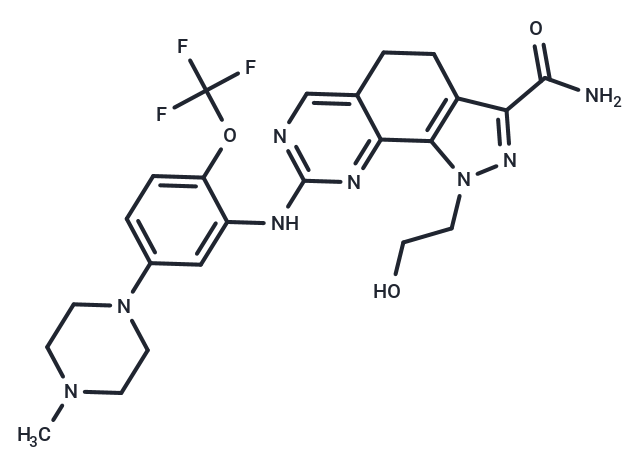Shopping Cart
Remove All Your shopping cart is currently empty
Your shopping cart is currently empty
Onvansertib (NMS-1286937) is a PLK1 inhibitor (IC50=2 nM) with high selectivity and oral activity. Onvansertib has antitumor activity and inhibits tumor growth.

| Pack Size | Price | USA Warehouse | Global Warehouse | Quantity |
|---|---|---|---|---|
| 1 mg | $30 | In Stock | In Stock | |
| 5 mg | $64 | In Stock | In Stock | |
| 10 mg | $89 | In Stock | In Stock | |
| 25 mg | $153 | In Stock | In Stock | |
| 50 mg | $239 | In Stock | In Stock | |
| 100 mg | $396 | In Stock | In Stock | |
| 500 mg | $829 | In Stock | In Stock | |
| 1 mL x 10 mM (in DMSO) | $75 | In Stock | In Stock |
| Description | Onvansertib (NMS-1286937) is a PLK1 inhibitor (IC50=2 nM) with high selectivity and oral activity. Onvansertib has antitumor activity and inhibits tumor growth. |
| Targets&IC50 | CK2:826 nM, PLK1:2 nM, MELK:744 nM, FLT3:510 nM |
| In vitro | METHODS: 137 tumor cells were treated with Onvansertib for 72 h. Cell viability was measured by CellTiter-Glo Assay. RESULTS: Sixty of the 137 cell lines had IC50 values below 100 nmol/L, and only 9 cell lines had IC50 values above 1 µmol/L, indicating a wide range of activity. [1] METHODS: Cisplatin-sensitive and -resistant CAL33 were treated with Onvansertib (25-50 nM) for 24 days, and the cell cycle was examined by Flow cytometry. RESULTS: Onvansertib treatment induced accumulation of all sensitive and resistant CAL33 cells in G2/M phase in a dose-dependent manner. [2] |
| In vivo | METHODS: To test the antitumor activity in vivo, Onvansertib (60 mg/kg) was administered orally to Hsd, athymic nu/nu mice bearing HCT116 xenografts once daily for eight days. RESULTS: Onvansertib was able to achieve good antitumor activity with minimal weight loss and inhibited tumor growth to a considerable extent with a TGI of 79%. [1] |
| Kinase Assay | Kinase profile: The inhibitory activity of putative kinase inhibitors and the potency of selected compounds are determined using a trans-phosphorylation assay. Specific peptide or protein substrates are trans-phosphorylated by their specific serine-threonine or tyrosine kinase, in the presence of ATP traced with 33P-γ-ATP, at optimized buffer and cofactors conditions. At the end of the phosphorylation reaction, more than 98% unlabeled ATP and radioactive ATP is captured by adding an excess of the ion exchange dowex resin; the resin then settles down to the bottom of the reaction plate by gravity. Supernatant, containing the phosphorylated substrate, is subsequently withdrawn and transferred into a counting plate, followed by evaluation by b-counting. Inhibitory potency evaluation for all the tested kinases was performed at 25 °C using a 60 min end-point assay where the concentrations of ATP and substrates are kept equal to 2 x αKm and saturated (>5 x αKm), respectively. |
| Cell Research | Cells are seeded into 96- or 384-well plates at densities ranging from 10,000 to 30,000/cm2 for adherent and 100,000/mL for nonadherent cells in appropriate medium supplemented with 10% fetal calf serum. After 24 hours, cells were treated in duplicate with serial dilutions of NMS-P937, and 72 hours later, the viable cell number was assessed by the CellTiter-Glo Assay (Promega). IC50 values were calculated with a sigmoidal fitting algorithm (Assay Explorer MDL). Experiments were carried out independently at least twice.(Only for Reference) |
| Synonyms | NMS-P937, NMS-1286937 |
| Molecular Weight | 532.52 |
| Formula | C24H27F3N8O3 |
| Cas No. | 1034616-18-6 |
| Smiles | CN1CCN(CC1)c1ccc(OC(F)(F)F)c(Nc2ncc3CCc4c(nn(CCO)c4-c3n2)C(N)=O)c1 |
| Relative Density. | 1.57 g/cm3 (Predicted) |
| Storage | Powder: -20°C for 3 years | In solvent: -80°C for 1 year | Shipping with blue ice/Shipping at ambient temperature. | ||||||||||||||||||||||||||||||
| Solubility Information | DMSO: 25 mg/mL (46.95 mM), Sonication and heating are recommended. Ethanol: 10 mg/mL (18.78 mM), Heating is recommended. H2O: < 1 mg/mL (insoluble or slightly soluble) | ||||||||||||||||||||||||||||||
| In Vivo Formulation | 10% DMSO+40% PEG300+5% Tween 80+45% Saline: 2 mg/mL (3.76 mM), Sonication is recommended. Please add the solvents sequentially, clarifying the solution as much as possible before adding the next one. Dissolve by heating and/or sonication if necessary. Working solution is recommended to be prepared and used immediately. The formulation provided above is for reference purposes only. In vivo formulations may vary and should be modified based on specific experimental conditions. | ||||||||||||||||||||||||||||||
Solution Preparation Table | |||||||||||||||||||||||||||||||
Ethanol/DMSO
DMSO
| |||||||||||||||||||||||||||||||
| Size | Quantity | Unit Price | Amount | Operation |
|---|

Copyright © 2015-2026 TargetMol Chemicals Inc. All Rights Reserved.